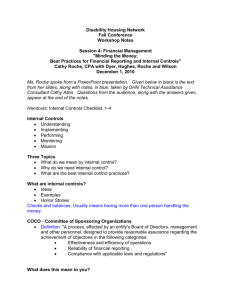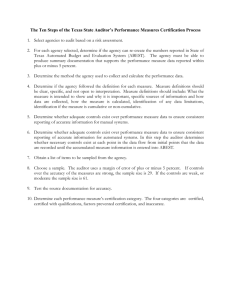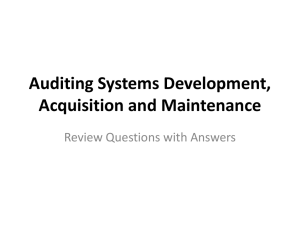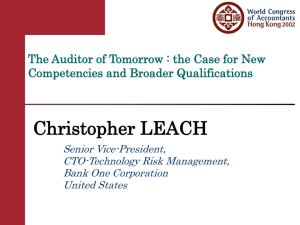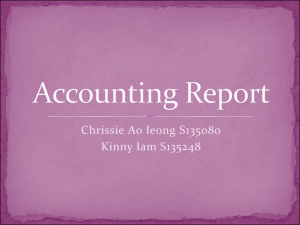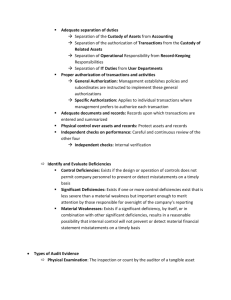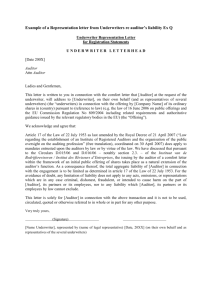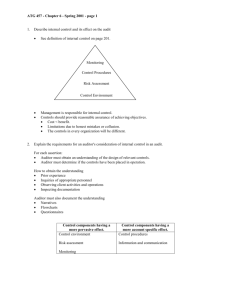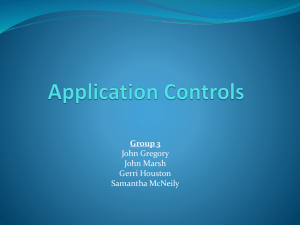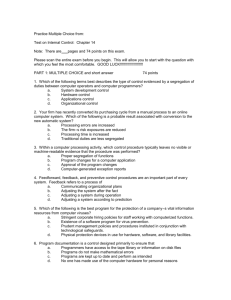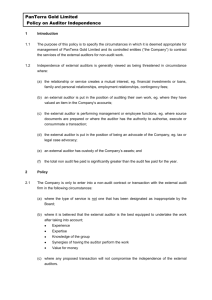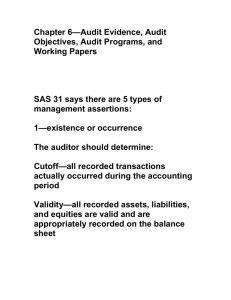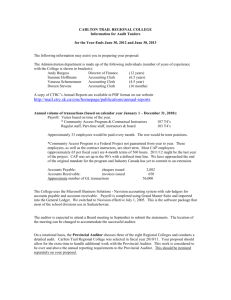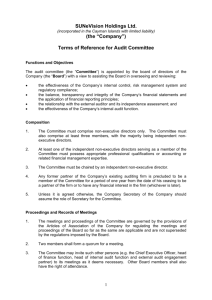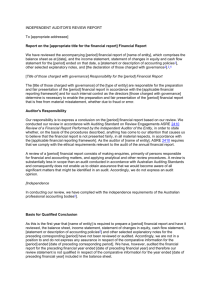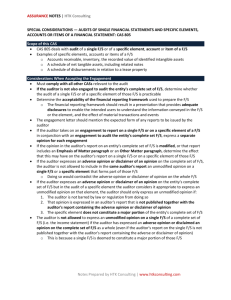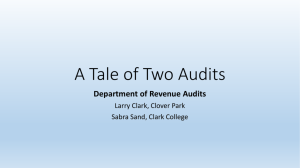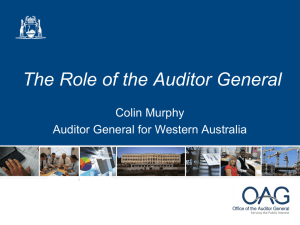MSA 516 Application Controls Project
advertisement
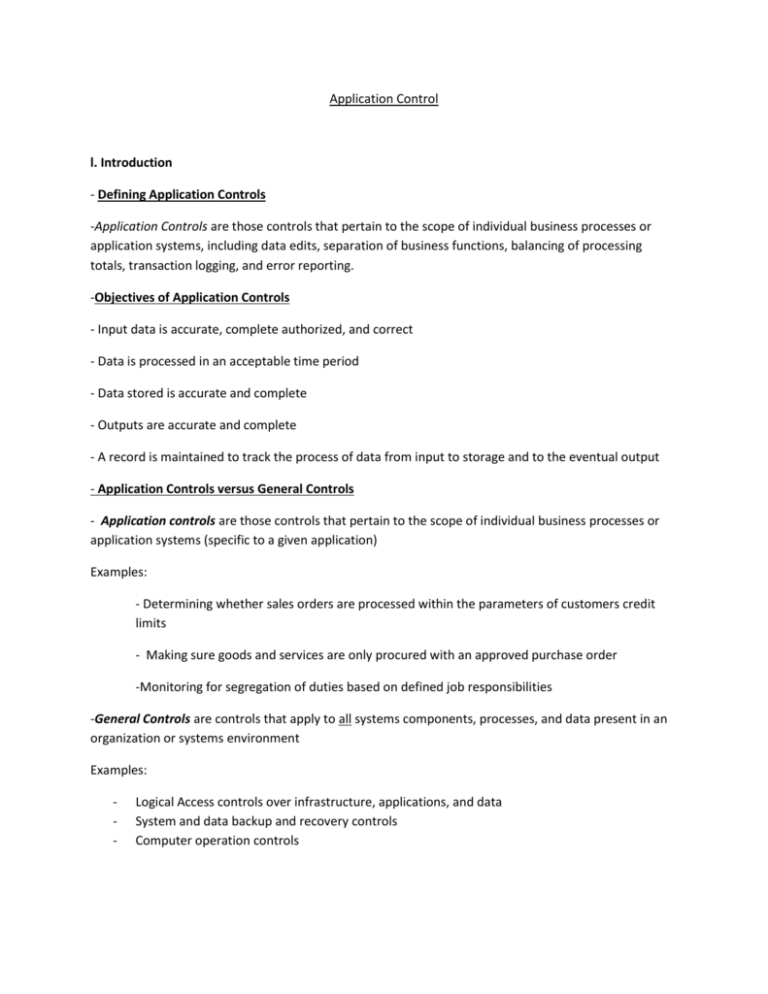
Application Control l. Introduction - Defining Application Controls -Application Controls are those controls that pertain to the scope of individual business processes or application systems, including data edits, separation of business functions, balancing of processing totals, transaction logging, and error reporting. -Objectives of Application Controls - Input data is accurate, complete authorized, and correct - Data is processed in an acceptable time period - Data stored is accurate and complete - Outputs are accurate and complete - A record is maintained to track the process of data from input to storage and to the eventual output - Application Controls versus General Controls - Application controls are those controls that pertain to the scope of individual business processes or application systems (specific to a given application) Examples: - Determining whether sales orders are processed within the parameters of customers credit limits - Making sure goods and services are only procured with an approved purchase order -Monitoring for segregation of duties based on defined job responsibilities -General Controls are controls that apply to all systems components, processes, and data present in an organization or systems environment Examples: - Logical Access controls over infrastructure, applications, and data System and data backup and recovery controls Computer operation controls ll. Risk Assessment Assess Risk - when assessing risk auditor should use a top-down risk assessment to determine which applications to include as part of the control review and what test are to be performed Application Control: Risk Assessment Approach -Define the universe of applications, databases, and supporting technology that use application controls - Define the risk factors associated with each application control: - Primary application controls - Pre-packaged or developed applications - The design effectiveness of application controls - Whether the application control supports more than one critical business process - Frequency and complexity of changes to applications - Financial impact of the application controls - The controls’ audit history - Weigh all risk to determine which risks need to be weighed more heavily than others - Qualitative rankings – High, Medium, Low - Quantitative rankings – Numerical Scale - Evaluate risk assessment results - Create risk review plan that is based on the risk assessment and ranked risk areas III. – Controls Benefits of Relying on Application Reliability - Once an application control is established, and there is little change to the application, database, or supporting technology, the organization can rely on the application control until a change occurs. - An application control will continue to operate more effectively if the general controls that have a direct impact on its programmatic nature are operating effectively as well. As a result, the auditor will be able to test the control once and not multiple times during the testing period. Benchmarking - - - If general controls that are used to monitor program changes, access to programs, and computer operations are effective and continue to be tested on a regular basis, the auditor can conclude that the application control is effective without having to repeat the previous year’s Control test. Auditor should evaluate the appropriate use of benchmarking or an automated control by considering how frequently the application changes. (If application changes frequently, auditor should not rely on benchmarking) Benchmarking is particularly effective use pre-packaged software that doesn’t allow for any source code development or modification. Organizations have to evaluate each application control to determine how long benchmarking can be effective When no longer effective you have to re-test the control Time and Cost Savings - Application controls generally take less time to test than application controls Application controls are typically tested one time as long as the general controls are effective -Types of Application Controls - - - Input Controls – check the integrity of data entered into a business application - Processing Controls – ensure processing is complete, accurate, and authorized - Output Controls – compare output results with expected results by checking the output against the input o Preventive, Detective, and Corrective Controls-are specific types of input, processing, and output controls - Integrity Controls- monitor data to ensure it remains consistent and correct - Management Trail (i.e. Audit trail) - monitors the effectiveness of other controls and identifies errors as close as possible to their sources lV. Auditing - Application Controls Scoping of Application Control Reviews Two methods for determining the review scope of application controls Business Process Model - Top-down review approach used to evaluate application controls in all systems that support a particular business process Single Application Method - Approach used to review the application controls within a single application Application Review Approaches and Other Considerations - Planning of Application Controls - After risk assessment and scope determination, auditor needs to develop and communicate a detailed review plan - Need for Specialized Audit Resources - Identify if an IT auditor will be needed - Testing Application Controls - Auditor should assess if application controls are working or if they are being circumvented by creative users or management override - Substantive testing on the efficacy of controls is needed rather than a review of control settings - Auditor may test application controls using several methods that are based on the type of application control these include - Inspection of system configurations - Inspection of user acceptance testing - Edit checks for key fields - Re-performance of the control activity using system data - Inspection of user access listings - Re-performance of the control activity in a test environment - Documentation Techniques for Application Controls - Flowcharts - Process Narratives
